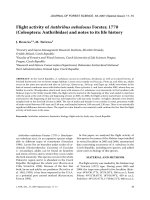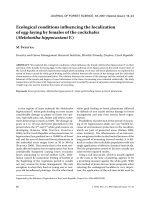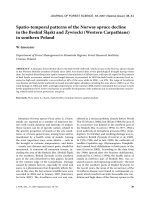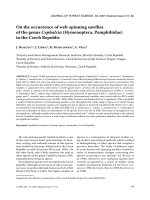Báo cáo lâm nghiệp: "of stem cuttings of Populus x euramericana under different water potentials" ppt
Bạn đang xem bản rút gọn của tài liệu. Xem và tải ngay bản đầy đủ của tài liệu tại đây (144.74 KB, 3 trang )
Rooting
of
stem
cuttings
of
Populus
x
euramericana
under
different
water
potentials
S. Puri
1
F.B.
Thompson
2
1
Department
of
Forestry,
Haryana Agriculture
University,
Hisar
125
004,
India,
and
2
Oxford
Forestry
Institute,
South
Parks
Road,
Oxford
OX1
3RB,
U.K.
Introduction
The
rooting
of
stem
cuttings
is
affected
by
many
environmental
factors
(Haissig,
1974;
Puri
and
Shamet,
1988).
The
main-
tenance
of
water
balance
is
one
of
the
important
factors.
The
water
balance
of
cuttings
is
affected
by
high
transpirational
water
losses
coupled
with
either
low
water
absorption
or
slow
water
transport
through
the
conducting
tissues.
However,
little
is
known
about
maintenance
and
control
of
plant
water
potential
during
the
rooting
of
cuttings.
The
present
studies
were
under-
taken
to
examine
rooting
as
influenced
by
initial
plant
water
potential.
Materials
and
Methods
Variation
in
the
initial
plant
water
potential
(4!P)
of
Populus
x
euramericana
was
obtained
by
3
pretreatments,
viz.,
fresh,
soaked
(5
d
in
water)
and
dried
(7
d
old
cuttings
kept
in
the
open).
Ini-
tial
Wp
were
-1.45, -
0.1
and
-2.1
MPa,
respec-
tively.
Cuttings
were
planted
in
a
mixture
of
peat
and
grit
sand
(1:1,
v/v),
maintained
at
-0.006
and
-0.06
MPa
by
weighing
the
pots
daily
and
adding
water
to
restore
these
soil
moisture
potentials.
Tensiometers
were
also
used
as
a
check.
The
pots
with
cuttings
were
kept
in
a
growth
chamber
at
25°C,
RH
at
70%
and
illumi-
nation
of
1000
foot
candles
for
16
h.
The
cut-
tings
were
assessed
for
shoot
and
root
de-
velopment,
moisture
content,
water
and
osmotic
potentials,
stomatal
diffusion
resistance,
relative
conductivity
and
starch
content.
Water
potentials
of
shoots
(V
shoot)
were
measured
with
a
pressure
chamber
(Scholan-
der
et
al.,
1964)
and
those
of
bark
(qJ bark)
according
to
the
Shardakov
method.
Osmotic
potential
(’P solute)
was
measured
with
a
Wes-
cor
C52
chamber
hygrometer
connected
to
a
Wescor
HR-33
T
microvolt
meter.
The
relative
conductivity
of
the
root
system
and
base
of
each
cutting
was
estimated
according
to
the
procedures
of
Ikeda
and
Suzaki
(1984).
Starch
was
extracted
from
the
stem
following
the
method
of
Dekker
and
Richards
(1971)
and
was
estimated
after
hydrolysis
to
glucose
by
the
method
of
Kilburn
and
Taylor
(1969).
Results
were
subjected
to
a
standard
analysis
of
vari-
ance
procedure
using
a
split
plot
design.
Results
and
Discussion
Root
initiation
per
se
in
poplar
is
not
an
obstacle
to
propagation,
but
moisture
sup-
ply
has
a
major
effect
on
successful
root-
ing.
The
water
stressed
cuttings
had
fewer
roots
and
these
grew
slowly
(both
in
num-
ber
and
length)
as
shown
in
Table
I.
Pre-
soaking
stimulated
rooting
and
enabled
cuttings
to
absorb
water
for
initial
root
development,
even
under
the
drier
soil
conditions
(-0.06
MPa).
The
stem
mois-
ture
of
fresh
and
dried
cuttings
increased
with
time.
The
moisture
content
of
soaked
cuttings
decreased
initially,
presumably
due
to
high
initial
moisture,
and
later
increased.
The
root
moisture
content
increased
initially
and
then
decreased
in
all
the
treatments.
This
is
attributed
to
the
observation
that,
during
early
develop-
ment
of
roots,
only
cell
elongation
and
cell
division
occur,
and
later
on
cell
differentia-
tion,
lignification
and
hardening
begin
(Esau, 1960).
Changes
in
shoot
water
potential,
rela-
tive
conductivity
and
starch
are
given
in
Table
I.
The
water
potential
of
fresh
and
dried
cuttings
increased
with
time
but
for
soaked
cuttings
it
decreased.
This
result
may
be
due
to
the
high
initial
71
of
soaked
cuttings.
Once
well-developed
roots
were
formed,
the
v!of
shoot
and
bark
stabilized,
irrespective
of
pretreatment.
The
turgor
pressure
more
or
less
fol-
lowed
the
pattern
of
y’
solute
but
exag-
gerated
any
rise
of
potential,
due
to
the
fall
in
’P bark
ofl:en
associated
with
rises
in
osmotic
potential
of
the
expressed
sap.
The
relative
conductivity
decreased
initial-
ly
and
then
increased
gradually.
This
decrease
may
be
due
to
decreased
water
absorption
by
the
cuttings
until
the
func-
tional
roots
were
formed.
Grange
and
Loach
(1983)
opined
that
the
decrease
in
water
absorption
of
cuttings
with
time
may
be
due
to
increased
resistance
to
water
influx
through
the
cut
surface.
Starch
acts
as
the
prime
carbohydrate
source
for
root
initiation
and
development
(Haissig,
1974).
In
the
present
studies,
it
decreased
with
time
irrespective
of
treat-
ment
(Table
I).
This
decrease
may
be
at-
tributable
to
the
export
of
starch
to
devel-
oping
roots
and
leaves.
Although
our
observations
were
limited
to
a
single
species
and
few
treatments,
they
suggest
that
the
levels
of
water
stress
imposed
on
the
cuttings
significant-
ly
influenced
rooting.
References
Dekker
R.F.H.
&
Richards
G.N.
(1971)
Determi-
nation
of
starch
in
plant
material.
J.
Sci.
Food
Agric.
22,
441-451
Esau
K.
(1960)
In:
Anatomy
of
Seed
Plants.
John
Wiley
&
Sons,
New
York
pp.
569
Grange
R.I.
&
Loach
K.
(1983)
The
water
econ-
omy
of
unrooted
leafy
cuttings.
J.
Hortic.
Sci.
58, 9-17
Haissig
B.E.
(1974)
Metabolism
during
adventi-
tious
root
primordium
initiation
and
develop-
ment.
New
Zealand
J.
For.
Sci.
4,
324-337
Ikeda
T.
&
Suzaki
T
(1984)
Distribution
of
xylem
resistance
to
water
flow
in
stems
and
branches
of
hardwood
species.
J.
Jpn.
For.
Soc.
66,
229-
236
Kilburn
D.M.
&
Taylor
P.M.
(1969)
Effect
of
sulf-
hydryl
reagents
on
glucose
determination
by
the
glucose
oxidase
method.
Anaf.
Biochem.
27, 555-558
Puri
S.
&
Shamet
G.S.
(1988)
Rooting
of
stem
cuttings
of
some
social
forestry
species.
Int.
Tree
Crops
J.
(U.K.)
5,
63-70
Scholander
P.F.,
Hammel
H.T.,
Hemmingsen
E.A.
&
Bradstreet
E.D.
(1964)
Hydrostatic
pres-
sure
and
osmotic
potentials
in
leaves
of
man-
groves
and
some
other
plants.
Proc.
Natl.
Acad.
Sci.
USA
51, 119-125









